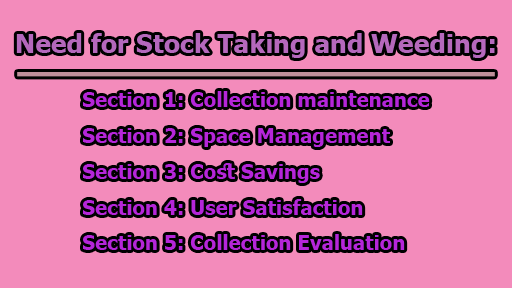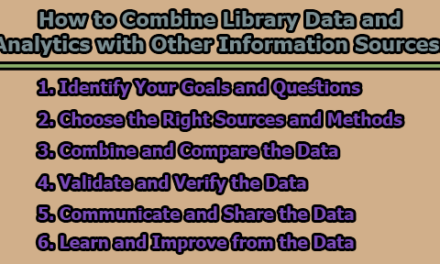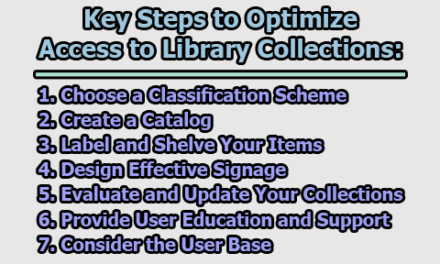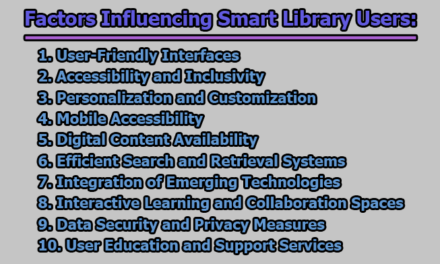Need for Stock Taking and Weeding:
Stock taking and weeding are essential practices in library management, as they play a crucial role in maintaining a healthy and relevant library collection. Let’s delve into the need for stock taking and weeding:
Section 1: Collection maintenance:
Libraries have a responsibility to maintain their collections in good condition and keep them relevant to their users. Regular stock taking and weeding help ensure that the collection remains up-to-date and useful to library users.
1.1 Preserving Relevance: Libraries serve as vital resources for communities, educational institutions, and researchers. To fulfill this role effectively, it’s imperative that their collections remain up-to-date and relevant. Here’s a closer look at the facets of collection maintenance:
- Current Knowledge: In a rapidly changing world, new information, discoveries, and research are constantly emerging. Libraries must ensure that their collections include the latest publications, research papers, and reference materials. Through stock taking, librarians verify the presence and condition of these items in the collection, ensuring that users have access to the most current knowledge available.
- Addressing User Needs: Library users have diverse needs and interests. They rely on the library to provide resources that are tailored to their specific requirements, whether they are students, academics, professionals, or simply individuals seeking to expand their knowledge. Regular stock taking helps librarians identify gaps in the collection and areas where additional materials are needed to meet these varying demands.
- Supporting Academic and Professional Growth: In educational settings, such as universities and schools, an up-to-date library collection is crucial for the success of students and faculty. Professors need the latest research materials to teach effectively, and students need them for their coursework. A well-maintained collection supports academic and professional growth by providing the most current and relevant resources.
1.2 Quality Control:
- Preventing Deterioration: As materials are used and handled, they can deteriorate over time. Regular stock taking allows librarians to assess the condition of items, identifying those that are damaged or in need of repair. This preventive approach helps extend the lifespan of materials, ensuring that they remain usable and in good condition for as long as possible.
- Eliminating Outdated Information: Information can quickly become outdated, especially in fields like science, technology, and medicine. Weeding out materials with obsolete or incorrect information is essential to maintaining the library’s integrity. When inaccurate information remains in the collection, it can mislead users and erode trust in the library’s resources.
- Enhancing User Experience: High-quality materials contribute to a positive user experience. Patrons are more likely to have a productive and satisfying experience when they can trust that the library’s resources are accurate and reliable. A well-maintained collection with materials in good condition is more likely to attract and retain users.
Collection maintenance through stock taking is a multifaceted process. It involves ensuring the library’s collection is up-to-date with the latest knowledge, meeting diverse user needs, and maintaining the quality of materials. By performing these activities, libraries can fulfill their mission to provide reliable, current, and high-quality resources to their users, fostering learning, research, and personal growth within the community.
Section 2: Space Management:
Libraries, regardless of their size and capacity, often face spatial limitations. Effectively managing space is vital to optimize the library’s functionality and user experience. Here’s a brief look at the key aspects of space management in libraries:
2.1 Maximizing Space: Efficient Use of Limited Space: Libraries typically have a finite amount of space, and this space must be used judiciously. Stock taking and weeding are instrumental in creating room for new acquisitions and improving the library’s layout. This process is particularly crucial for libraries operating in urban or crowded settings where expanding physical space may be challenging.
- User Comfort: An overcrowded library can be uncomfortable and frustrating for users. By removing outdated or rarely used materials through weeding, the library can free up space, allowing users to move around easily and access resources without feeling cramped.
- Creating Functional Spaces: Space management also involves designating areas within the library for different purposes. For example, providing quiet study spaces, collaborative work areas, and computer stations. By optimizing space through weeding, libraries can allocate areas to meet the specific needs of their patrons.
- Aesthetics and Accessibility: An organized and uncluttered library space is more aesthetically pleasing and inviting to users. Weeding helps in decluttering, which not only makes the library more attractive but also enhances accessibility by making materials and resources easier to find.
- Adapting to Changing Needs: Communities evolve, and so do the needs of library users. Space management allows libraries to be flexible and adaptable. For example, if there is a growing demand for e-books or digital resources, freeing up space once occupied by physical materials can be essential for accommodating new technology and service offerings.
- Storage Efficiency: Libraries often have storage areas or archives for materials that are not frequently accessed but are still valuable. Space management includes optimizing these storage areas to make retrieval efficient while ensuring that valuable items are preserved properly.
Effective space management in libraries is essential for creating a welcoming and functional environment for users. It ensures that space is used efficiently, making room for new materials and services, and adapting to evolving community needs. An organized and spacious library layout enhances user comfort, accessibility, and overall user experience. It is an integral part of library management that, when done well, contributes to the library’s success in serving its community.
Section 3: Cost Savings:
Cost-saving is a significant benefit that results from the diligent practice of stock taking and weeding in libraries. This practice can lead to more efficient financial management and resource allocation. Here’s a dive into the various aspects of cost savings in library management:
3.1 Avoiding Redundancy:
- Preserving Existing Resources: By regularly assessing the condition of items through stock taking, libraries can identify and address damage or wear before it becomes irreparable. This preventive approach can extend the lifespan of materials, reducing the need to replace them with new copies.
- Minimizing Replacement Costs: Weeding allows libraries to identify and remove materials that are no longer in usable condition or have become irrelevant. By doing so, libraries can avoid the costs associated with purchasing replacement copies. This is especially important for rare or expensive items that may not be readily available for repurchase.
3.2 Allocating Resources Efficiently:
- Reallocating Budget: Funds that were previously allocated to maintaining, replacing, or storing damaged or outdated materials can be reallocated to the acquisition of new, relevant resources. This reallocation ensures that the library’s budget is used effectively to meet the needs of its users and expand its collection with current and in-demand materials.
- Enhancing Return on Investment: A well-maintained and relevant collection increases the return on investment for the library. Patrons are more likely to utilize resources that are up-to-date and of high quality, ensuring that the library’s financial resources are spent on materials that are actively serving their community.
- Reducing Maintenance Costs: Regular stock taking and weeding can also help reduce the costs associated with the maintenance of materials. By addressing issues early, libraries can save on the expenses of repairing, rebinding, or preserving materials that have deteriorated beyond repair.
3.3 Supporting Long-Term Sustainability:
- Environmental Impact: Weeding also contributes to sustainability efforts. By removing materials that are no longer relevant or in demand, libraries reduce the environmental impact associated with the production, transportation, and disposal of physical resources.
Cost savings in library management are closely linked to stock taking and weeding. These practices help libraries avoid the unnecessary cost of replacing damaged or outdated materials, reallocate resources more efficiently, and enhance the overall return on investment. By preserving existing resources and making strategic decisions regarding collection development, libraries can maximize the value they provide to their users within their budget constraints while also contributing to sustainability efforts.
Section 4: User Satisfaction:
User satisfaction is a fundamental goal for libraries, and it is directly impacted by the practices of stock taking and weeding. Maintaining a relevant and up-to-date collection is key to meeting the needs and expectations of library users. Here’s a look into how user satisfaction is influenced by these practices:
4.1 Meeting User Expectations:
- Access to Current Information: Users, whether they are students, researchers, or community members, expect the library to provide access to the most current and relevant information and resources. Regular stock taking ensures that the collection remains up-to-date, offering users the latest knowledge and materials.
- Relevance to Diverse User Needs: Libraries serve a wide range of patrons with diverse interests and requirements. Weeding helps libraries tailor their collections to meet these needs. By removing outdated or irrelevant materials and making space for new acquisitions, libraries can better align their collections with the interests of their users.
- Quality Resources: Users appreciate high-quality resources. Weeding helps to maintain the quality of the collection by eliminating materials that are damaged, worn, or contain outdated or incorrect information. This ensures that users have access to reliable and credible materials.
4.2 Enhancing the User Experience:
- Efficiency and Accessibility: An organized and relevant collection makes it easier for users to find what they need quickly and efficiently. Weeding ensures that resources are well-organized and easily accessible, improving the overall user experience.
- User-Friendly Space: Creating a comfortable and inviting library space, with ample room for movement and study, enhances user satisfaction. By freeing up space through weeding, libraries can provide a more pleasant and welcoming environment.
- Positive Engagement: When users find materials that are current, relevant, and in good condition, they are more likely to engage with the library’s resources, whether for research, learning, or personal enjoyment. This positive engagement contributes to user satisfaction and loyalty.
4.3 Adaptation to User Preferences:
- Feedback Integration: Libraries often seek and incorporate user feedback into their collection development processes. Stock taking and weeding provide opportunities to respond to user preferences and demands. By analyzing usage statistics and listening to user suggestions, libraries can ensure that their collections align with what users want.
- Tailored Collection: A library’s ability to curate a collection that is tailored to its user base helps build trust and loyalty. Users are more likely to return to a library that consistently provides them with the materials they need and want.
User satisfaction is at the core of library service, and stock taking and weeding are vital to achieving this goal. By ensuring that the collection is current, relevant, and of high quality, libraries can meet the diverse needs and expectations of their users. Additionally, an organized and user-friendly library space enhances the overall experience, making users more likely to engage with the library’s resources and fostering a positive and lasting relationship between the library and its community.
Section 5: Collection Evaluation:
Collection evaluation is an essential aspect of library management, and stock taking and weeding provide valuable opportunities for libraries to assess and improve their collections. Here’s a dive into how collection evaluation is facilitated by these practices:
5.1 Informed Decision-Making:
- Usage Statistics: Regular stock taking helps libraries gather data on the use and popularity of different materials. By analyzing this data, libraries can identify which items are in high demand and which are underutilized. This information informs decisions about which materials to acquire, retain, or remove.
- Assessing Material Condition: Stock taking involves checking the physical condition of materials. This evaluation helps libraries determine if materials are in need of repair, replacement, or weeding. It ensures that resources are in good condition for users and informs decisions on resource preservation.
- Relevance to Mission and Goals: Libraries have specific missions and goals that guide their collection development. Stock taking and weeding provide opportunities to assess whether the collection aligns with these mission and goals. If materials no longer serve the library’s mission, they can be considered for removal.
5.2 Resource Allocation:
- Budget Allocation: By reallocating budget resources from weeding and maintenance to the acquisition of new materials, libraries can make informed decisions about how to maximize their budget to meet user needs effectively.
- Strategic Collection Development: The information gathered through stock taking and weeding helps libraries make strategic decisions about the future of their collections. They can identify areas where new acquisitions are needed to fill gaps or areas where older materials can be phased out.
5.3 Quality Improvement:
- Enhancing the Collection’s Quality: Through stock taking and weeding, libraries can maintain the overall quality of their collections by removing damaged, outdated, or irrelevant materials. This process ensures that users have access to high-quality resources.
- Selection of New Materials: Collection evaluation aids in selecting new materials that are in line with current research and user needs. By knowing what is already available, libraries can make informed decisions about what to add to the collection.
5.4 Fulfilling Mission and Vision:
- Adapting to Changing Demands: Collection evaluation allows libraries to adapt to changing demographics, educational trends, and user preferences. By regularly assessing their collections, libraries can stay in step with the evolving needs of their communities.
- Continuous Improvement: Libraries that embrace collection evaluation as part of their routine management can continuously improve their offerings and services. This reflects positively on their mission to provide the best possible resources and support for their users.
Collection evaluation through stock taking and weeding is essential for making informed decisions about collection development and resource allocation. It helps libraries align their collections with their missions and goals, improve their quality, and adapt to changing demands. This data-driven approach ensures that libraries continue to be valuable and relevant institutions, providing the resources their users need to learn, research, and grow.
In conclusion, stock taking and weeding are indispensable activities in library management. They ensure that the library collection remains dynamic, pertinent, and in excellent condition. By systematically assessing the collection, removing outdated or irrelevant materials, and reallocating resources efficiently, libraries can optimize their services, save costs, and enhance user satisfaction. Additionally, the data obtained during these processes empowers libraries to make informed decisions that further improve the overall quality and relevance of their collections.

Former Student at Rajshahi University










